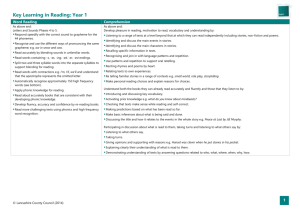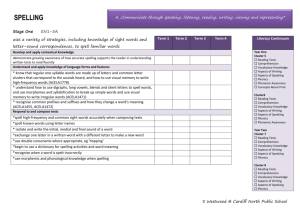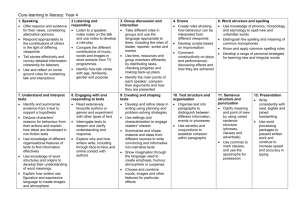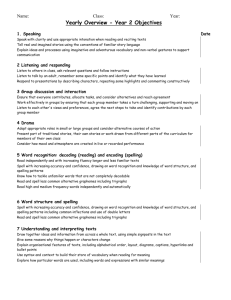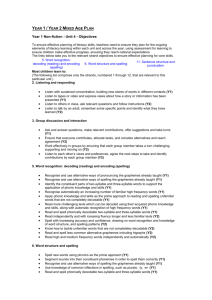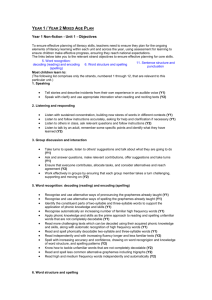Year 1 Core Learning in literacy by year
advertisement
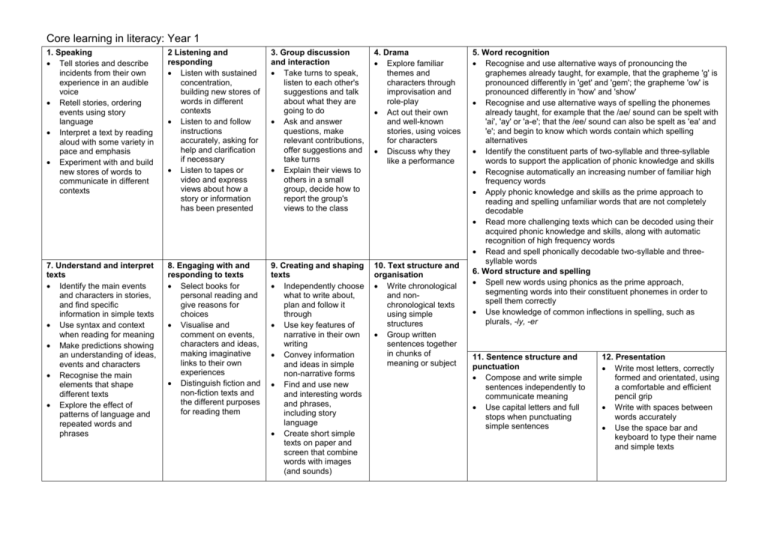
Core learning in literacy: Year 1 1. Speaking Tell stories and describe incidents from their own experience in an audible voice Retell stories, ordering events using story language Interpret a text by reading aloud with some variety in pace and emphasis Experiment with and build new stores of words to communicate in different contexts 2 Listening and responding Listen with sustained concentration, building new stores of words in different contexts Listen to and follow instructions accurately, asking for help and clarification if necessary Listen to tapes or video and express views about how a story or information has been presented 3. Group discussion and interaction Take turns to speak, listen to each other's suggestions and talk about what they are going to do Ask and answer questions, make relevant contributions, offer suggestions and take turns Explain their views to others in a small group, decide how to report the group's views to the class 4. Drama Explore familiar themes and characters through improvisation and role-play Act out their own and well-known stories, using voices for characters Discuss why they like a performance 7. Understand and interpret texts Identify the main events and characters in stories, and find specific information in simple texts Use syntax and context when reading for meaning Make predictions showing an understanding of ideas, events and characters Recognise the main elements that shape different texts Explore the effect of patterns of language and repeated words and phrases 8. Engaging with and responding to texts Select books for personal reading and give reasons for choices Visualise and comment on events, characters and ideas, making imaginative links to their own experiences Distinguish fiction and non-fiction texts and the different purposes for reading them 9. Creating and shaping texts Independently choose what to write about, plan and follow it through Use key features of narrative in their own writing Convey information and ideas in simple non-narrative forms Find and use new and interesting words and phrases, including story language Create short simple texts on paper and screen that combine words with images (and sounds) 10. Text structure and organisation Write chronological and nonchronological texts using simple structures Group written sentences together in chunks of meaning or subject 5. Word recognition Recognise and use alternative ways of pronouncing the graphemes already taught, for example, that the grapheme 'g' is pronounced differently in 'get' and 'gem'; the grapheme 'ow' is pronounced differently in 'how' and 'show' Recognise and use alternative ways of spelling the phonemes already taught, for example that the /ae/ sound can be spelt with 'ai', 'ay' or 'a-e'; that the /ee/ sound can also be spelt as 'ea' and 'e'; and begin to know which words contain which spelling alternatives Identify the constituent parts of two-syllable and three-syllable words to support the application of phonic knowledge and skills Recognise automatically an increasing number of familiar high frequency words Apply phonic knowledge and skills as the prime approach to reading and spelling unfamiliar words that are not completely decodable Read more challenging texts which can be decoded using their acquired phonic knowledge and skills, along with automatic recognition of high frequency words Read and spell phonically decodable two-syllable and threesyllable words 6. Word structure and spelling Spell new words using phonics as the prime approach, segmenting words into their constituent phonemes in order to spell them correctly Use knowledge of common inflections in spelling, such as plurals, -ly, -er 11. Sentence structure and punctuation Compose and write simple sentences independently to communicate meaning Use capital letters and full stops when punctuating simple sentences 12. Presentation Write most letters, correctly formed and orientated, using a comfortable and efficient pencil grip Write with spaces between words accurately Use the space bar and keyboard to type their name and simple texts
